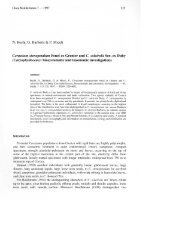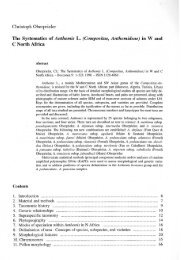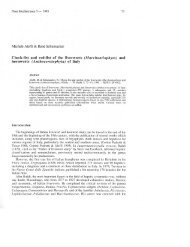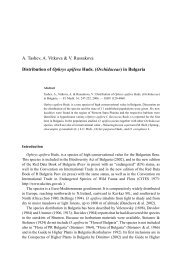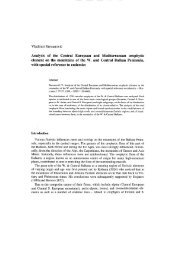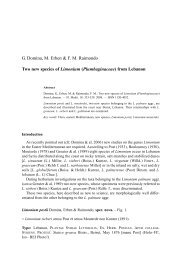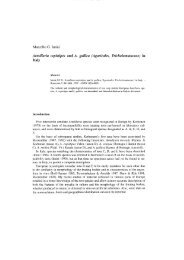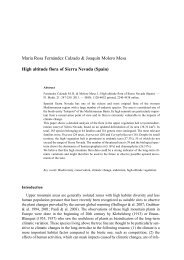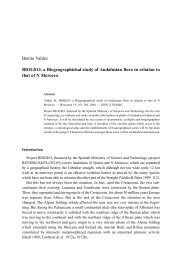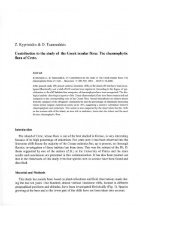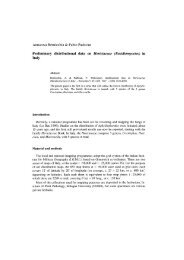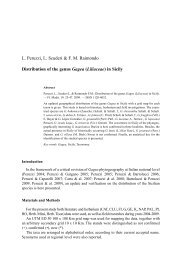Brullo & al. - Herbmedit.org
Brullo & al. - Herbmedit.org
Brullo & al. - Herbmedit.org
Create successful ePaper yourself
Turn your PDF publications into a flip-book with our unique Google optimized e-Paper software.
S. <strong>Brullo</strong>, A. Guglielmo, P. Pavone & C. S<strong>al</strong>meri<br />
Cytotaxonomic<strong>al</strong> remarks OD Alliump<strong>al</strong>lens and its relationships with A.<br />
conv<strong>al</strong>larioides (Alliaceae)<br />
Introduction<br />
Abstract<br />
<strong>Brullo</strong>, S., Guglielmo, A., Pavone, P. & S<strong>al</strong>meri, C.: Cytotaxonomic<strong>al</strong> remarks on Allium p<strong>al</strong>lens<br />
and its relationships with A. conv<strong>al</strong>larioides (Alliaceae). - Bocconea 16(2): 557-571. 2003.<br />
ISSN 1120-4060.<br />
Taxonomy, karyology, chorology and ecology of A. p<strong>al</strong>lens L., a circummediterranean species<br />
occurring in synanthropic habitats, are examined. ]t is closely related to A. conv<strong>al</strong>larioides<br />
Grossh., a diploid species linked to natur<strong>al</strong> habitats, which can be considered its probable ancestor.<br />
Within Allium sect. Codonoprasum Reichenb., A. p<strong>al</strong>lens L. is a criticai species, often<br />
taxonomic<strong>al</strong>ly misidentified in the European and Mediterranean Floras. Herbarium and<br />
field investigations <strong>al</strong>lowed to clarify the taxonomic<strong>al</strong> aspects and the relationships with<br />
<strong>al</strong>lied species.<br />
According to <strong>Brullo</strong> & <strong>al</strong>. (1996a, 1996b), A. p<strong>al</strong>lens is a synanthropic species, widespread<br />
in the Mediterranean range, occurring in field crops, uncultivated lands, road sides, meadows<br />
and clearings of the maquis where it flowers in early summer.<br />
On the whole, A. p<strong>al</strong>lens seems to be <strong>al</strong>lied to A. conv<strong>al</strong>larioides Grossh. in having similar<br />
habit, globose umbel, spathe v<strong>al</strong> ves unequ<strong>al</strong> and longer than the umbel, campanulate<br />
perigon with white and sm<strong>al</strong>l tep<strong>al</strong>s, anthers exserted. All these characters approach the<br />
two species to some ones of A. staticiforme Sm. group, and, in particular, to A. myrianthum<br />
Boiss.<br />
In order to emphasize the relationships among these species, morphologic<strong>al</strong> and<br />
karyologic<strong>al</strong> investigations were carried out on living materi<strong>al</strong> coming from sever<strong>al</strong><br />
Mediterranean loc<strong>al</strong>ities.<br />
Materi<strong>al</strong>s and methods<br />
The investigation was based on specimens collected in Spain, It<strong>al</strong>y, France, Greece,<br />
Turkey and Morocco and cultivated in the Botanic Garden ofCatania University. In addition,<br />
materi<strong>al</strong> from various herbaria was examined (ATH, B, BC, BCF, BM, BOLO, CAT, FI,
558 <strong>Brullo</strong> & <strong>al</strong>.: Cytotaxonomic<strong>al</strong> remarks on ...<br />
FI-WEBB, G, G-BOISS, HIU, ISTE, K, LINN, M, MA, MPU, NAP-TEN, OXF, P, PA, PI,<br />
PR, PRC, RO, SEV, W, WU).<br />
For karyologic<strong>al</strong> investigations, root-tips of bulbs were pre-treated with 0,3%<br />
colchicine, fixed in Carnoy and stained according to Feulgen technique. The studied<br />
po-pulations are listed in Table I.<br />
Table l. List of karyologic<strong>al</strong>ly studied populations.<br />
Results and discussion<br />
A. p<strong>al</strong>lens Biancavilla Sicily<br />
San Giacomo Sicily<br />
Levanzo Sicily<br />
Lampedusa Sicily<br />
Trebisacce C<strong>al</strong>abria<br />
G<strong>al</strong>lipoli Apulia<br />
Magliano Sabina Latium<br />
Livorno Tuscany<br />
Marseille France<br />
Cadiz Spain<br />
Casti Ilo de Locuba Spain<br />
Majorca Spain<br />
Kav<strong>al</strong>a Greece<br />
Delphi Greece<br />
Mycene Greece<br />
Didirne Turkey<br />
Anti Atlas, Igrern Marocco<br />
A. conv<strong>al</strong>larioides Manisa Dag Turkey<br />
Menernenciz (lzrnir) Turkey<br />
1) Allium p<strong>al</strong>lens L., Sp. Pl. ed. 2, 427, 1762 (Fig. l)<br />
2n=32<br />
2n=32<br />
2n=32<br />
2n=32<br />
2n=32<br />
2n=32<br />
2n=32<br />
2n=32<br />
2n=32<br />
2n=32<br />
2n=32<br />
2n=32<br />
2n=32<br />
2n=32<br />
2n=32<br />
2n=32<br />
2n=32<br />
2n=16<br />
2n=16<br />
Lectotypus: LINN 419.20 proposed here.<br />
Syn.: A. coppo/eri Tineo, Cat. Pl. Horti Panorm.: 275, 1827<br />
Lectotypus: Villabate, Tineo (FI!) proposed here.<br />
A. collinum Guss. in Ten., Fl. Neap. Syll.: 169, 1831 .<br />
Lectotypus: C<strong>al</strong>abria, Guss. (NAP!) proposed here.<br />
A. amblyanthum Zahariadi, Biol. G<strong>al</strong>lo-Hellen. 6(1): 53, 1975<br />
Holotypus : Kifissia, Attica, VI. 1974, Embiricos (ATH)<br />
A. stearnii Pastor & V<strong>al</strong>dés, Rev. Allium Penins. Iber. Is. B<strong>al</strong>ear.: 86, 1983<br />
Holotypus: Cordoba prope El Tejar, ubi die, 7. VII. 1982, Pastor &<br />
V<strong>al</strong>dés 77594 (SEV!)
Bocconea 16(2) - 2003<br />
Fig. 1. Allium p<strong>al</strong>lens L. A: habit; B: flower; C: perigon with stamens; D: ovary; E: anther; F:<br />
capsule; G: spathe v<strong>al</strong>ves.<br />
G<br />
559
562 <strong>Brullo</strong> & <strong>al</strong>.: Cytotaxonomic<strong>al</strong> remarks on ...<br />
Karyology<br />
For the karyologic<strong>al</strong> study, populations coming from sever<strong>al</strong>loc<strong>al</strong>ities ofMediterranean<br />
range were examined (Table l).<br />
Ali the observed materi<strong>al</strong> shows a chromosome complement 2n=32 (Fig. 3). Therefore<br />
Allium p<strong>al</strong>lens is a tetraploid species, but four homologous sets of chromosomes were not<br />
pointed out. In particular, the karyotype is characterized by 14 metacentric pairs, some of<br />
them microsatellited, and two submetacentric pairs.<br />
The chromosome formula is 2n=4x=32: 26 m + 2 mi + 4sm.<br />
Taxonomic remarks<br />
Allium p<strong>al</strong>lens was described by Linnaeus (1762) who emphasizes in the protologue:<br />
p<strong>al</strong>lens. 18. ALLIUM caule subteretifolio umbellifero, tloribus pendulis truncatis,<br />
staminibus simplicibus corollam aequantibus.<br />
Allium umbella non bulbifera lutea, vagina bicornis, foliis teretibus. H<strong>al</strong>l. <strong>al</strong>i. 21.<br />
Allium montanum bicorne, flore p<strong>al</strong>lido odoro. Bauh. pino 75.<br />
Gethioides sylvestre. Colum. ecphr. 2. p. 6. t. 7. f 2.<br />
Caulis biped<strong>al</strong>is, teres, laevis. Folia <strong>al</strong>terna, semiteretia, fistolosa, eptagona, erecta.<br />
Spata subulata, nervosa. Corolla campanulata, truncata, <strong>al</strong>ba. Pet<strong>al</strong>is obovatis,<br />
obtusissimis, erectis, concavis, carina viridi. Stamina simplicia, longitudine pet<strong>al</strong>orum.<br />
Flores mox a florescentia pendent. Stylus vix ullus, post anthesin excrescens, brevissimus.<br />
As regards lectotypification ofthis Linnaean species, De Wilde Duyfjes (1973) choosed<br />
the specimen S 139.9, conserved in the Linnaean Herbarium in Stockholm as type, pointing<br />
out that this specimen carne from centrai part of Asia corresponding to the Middle East, as<br />
means the sign e. This lectotypification is not acceptable because Linnaeus in the<br />
protologue does not quote Asia as origin of the species. Therefore, another lectotype must<br />
be designated. In the Linnaean Herbarium (London) is preserved an Allium LINN 419.20<br />
with a label where it is annoted "n. 8 an Allium p<strong>al</strong>lens - revera styli non elongatus nisi<br />
prius stans deflorata". The specimen ofthis sheet is characterized by a big size, bulb lacking,<br />
stem cylindric<strong>al</strong>, leaves ribbed, fistulous, spathe longer than inflorescence, plurinerved,<br />
some flowers pendulous, perigon campanulate, truncate, whitish, stamens subequ<strong>al</strong> or<br />
slightly exserted from perigon, style short. These characters well agree with the description of<br />
the protologue and consequentty LINN 419.20 is chosen as new lectotype of A. p<strong>al</strong>lens.<br />
On the basis of herbarium and literature investigations, it was possible to ascertain that<br />
this species was later described by Tineo (1827) sub A. coppoleri on materi<strong>al</strong> coming from<br />
a piace near P<strong>al</strong>ermo (Sicily) and by Gussone (Tenore 1831) sub A. collinum on specimens<br />
collected in S C<strong>al</strong>abria. Synonyms of A. p<strong>al</strong>lens must <strong>al</strong>so be considered A. amblyanthum<br />
described by Zahariadi (1975) from Greece and A. stearnii described by Pastor & V<strong>al</strong>dés<br />
(1983) from Spain.<br />
2) Allium conv<strong>al</strong>larioides Grossh. in Grossh. & Schischkin., Schedo Herb. P\. Or. Exsicc.<br />
1924: no. 107 (1924) (Fig. 4).<br />
Lectotypus: Transcaucasia, pro et dist. Erivan prope Dzhirvish in siccis, 20.7.1919,<br />
Grossheim 107 (K!).
Bocconea 16(2) - 2003 563<br />
Fig. 4. Allium conv<strong>al</strong>larioides Grossb. A: babit; B: flower; C: perigon witb stamens; D: ovary; E:<br />
antber; F: capsule.<br />
D<br />
BCF
564 <strong>Brullo</strong> & <strong>al</strong>.: Cytotaxonomic<strong>al</strong> remarks on ...<br />
Bulb ovoid, 15-20 x 12-18 mm, sometimes bulbilliferous, with membranous whitish<br />
tunics, the outer often dark brown. Stem 40-70 cm high, cylindric<strong>al</strong>, glabrous, erect, covered<br />
for 1/3-1/2 of its length by the leaf sheaths. Leaves 4-5 , semicylindric<strong>al</strong>, glabrous, green,<br />
ribbed, fistulous, up to 15 cm long and 1-2 mm wide. Spathe persistent, with 2 v<strong>al</strong> ves<br />
unequ<strong>al</strong>, longer than the inflorescence, 5-7 -nerved, the larger 4-5 mm long, the sm<strong>al</strong>ler<br />
2,5-4,5 mm long. Bostryces 12. Inflorescence globose to subglobose, 3-5 cm in diameter,<br />
dense, many-flowered, with subequ<strong>al</strong> pedicels 10-28 mm long. Perigon campanulate, with<br />
tep<strong>al</strong>s equ<strong>al</strong>, white, oblong, rounded at the apex, 3,5-4 mm long, the outer 2,2 mm wide,<br />
the inner 2 mm wide, midrib greenish-white. Stamens exserted from perigon, with simple<br />
white filaments, subequ<strong>al</strong>, 2,5-3 mm long, below connate into an annulus 1,2-1 ,3 mm high<br />
with interstamin<strong>al</strong> teeth. Anthers yellow, elliptic<strong>al</strong>, 1,2-1 ,3 x 0,7 mm, apiculate at the apex.<br />
Ovary ellipsoid, white tinged with green, smooth, 2,8-3 x 2-2,1 mm. Style white, 2-2,5 mm<br />
long. Capsule triv<strong>al</strong>ved, subglobose-obovoid, 4,5 x 4,5 mm.<br />
Ecology<br />
A. conv<strong>al</strong>larioides is norm<strong>al</strong>ly linked to natur<strong>al</strong> habitats as rocky places, garigues or<br />
steppe prairies.<br />
A<br />
B<br />
IllIiillllllnll<br />
1111111111111111<br />
10lim<br />
Fig. 5. Mitotic metaphase plates and karyograms<br />
of A. conv<strong>al</strong>larioides from Manisa Dag.
Bocconea 16(2) - 2003 565<br />
Geographic<strong>al</strong> distribution<br />
At present this species seems to be circumscribed to some loc<strong>al</strong>i ti es of the Middle East,<br />
extending eastwards to Iran. In particular it occurs in Anatolia, Caucasus, Iran and Iraq (Fig. 2).<br />
Karyology<br />
Allium conv<strong>al</strong>larioides is a diploid species with 2n=16; its chromosome complement is<br />
quite homogeneous and shows 7 metacentric pairs, one of them macrosatellited on the<br />
short arm, and one submetacentric pair (Fig. 5). The chromosome formula can be resumed<br />
as 2n=2x=16: 12 m + 2 mI + 2 sm.<br />
The karyotype ofthis species is on the whole morphologic<strong>al</strong>ly quite similar to that one<br />
of A. p<strong>al</strong>lens.<br />
Taxonomic remarks<br />
Previously A. conv<strong>al</strong>larioides was doubtfully considered by Kollmann (1984) as a<br />
synonym of A. myrianthum Boiss. due to the globose inflorescence and stamens exserted<br />
from the perigon, apart for the big size. Morphologic<strong>al</strong> and karyologic<strong>al</strong> study carried on<br />
living materi<strong>al</strong> trom a lot of loc<strong>al</strong>ities, including its fo cus classicus, emphasized that A.<br />
myrianthum is well differentiated trom A. conv<strong>al</strong>larioides (<strong>Brullo</strong> & <strong>al</strong>. 1995). There are<br />
<strong>al</strong>so remarkable differences from the ecologic<strong>al</strong> point of view, because A. myrianthum is a<br />
species linked to damp soils of therm<strong>al</strong> springs and marshes in the Middle East.<br />
Conclusions<br />
Among the species of Allium sect. Codonoprasum, A. p<strong>al</strong>lens shows closer relationships<br />
with A. conv<strong>al</strong>larioides, in having a big size, semicylindric<strong>al</strong> and fistulous leaves, globose<br />
umbel, spathe v<strong>al</strong> ves unequ<strong>al</strong> longer than the inflorescence, perigon campanulate with<br />
tep<strong>al</strong>s white and sm<strong>al</strong>l, anthers exserted trom the perigon. However, they differ in some<br />
morphologic<strong>al</strong> features: in particular A. p<strong>al</strong>lens has tep<strong>al</strong>s elliptic<strong>al</strong>-oblong to oblongovate,<br />
truncate or subobtuse at the apex, 4-4,5 mm long, stamens up to 4 mm long, connate<br />
into an annulus l mm high without interstamin<strong>al</strong> teeth, anthers rounded at apex, ovary 3-<br />
4 mm long, capsule subglobose. Instead, A. conv<strong>al</strong>larioides is characterized by tep<strong>al</strong>s<br />
oblong, rounded at the apex, 3,5-4 mm long, stamens up to 3 mm long, connate into an<br />
. annulus 1,2-1 ,3 mm high with interstamin<strong>al</strong> teeth, anthers apiculate at apex, ovary 2,8-3<br />
mm long, capsule subglobose-obovoid.<br />
As regards karyologic<strong>al</strong> aspects, A. p<strong>al</strong>lens is a tetraploid species, while A. conv<strong>al</strong>larioides<br />
is diploid; however the lack of an arrangement in four chromosome sets in A. p<strong>al</strong>lens<br />
makes unlikely its autopolyploid origin from populations of A. conv<strong>al</strong>larioides. More<br />
detailed investigations on meiotic chromosome behaviour and biomolecular studies will be<br />
required.<br />
Other differences concem the ecologic<strong>al</strong> requirements: A. p<strong>al</strong>lens is a synanthropic<br />
species, gener<strong>al</strong>ly occurring in nitrophilous habitats, while A. conv<strong>al</strong>larioides is linked to<br />
natur<strong>al</strong> environments.<br />
The two species are well distinguished in their geographic<strong>al</strong> distribution too because A.<br />
p<strong>al</strong>lens is widespread <strong>al</strong>i around Mediterranean area and A. conv<strong>al</strong>larioides is circumscribed<br />
to the Middle East where it shows a scattered distribution.
566 <strong>Brullo</strong> & <strong>al</strong>.: Cytotaxonomic<strong>al</strong> remarks on ...<br />
Therefore, A. conv<strong>al</strong>larioides can be considered the more ancestr<strong>al</strong> unit from which A.<br />
p<strong>al</strong>lens arised owing to adaptation to synanthropic habitats, thanks to polyploidisation and<br />
bulbilliferous vegetative reproduction. Polyploidy, in fact, is an important factor in favouring<br />
the colonization ofnew habitats, such as the secondary ones (Pignatti 1961); moreover the<br />
bulblets production makes easier a wide spreading of populations.<br />
Because of close morphologic<strong>al</strong> similarity, it is possible to hypothesize that A. conv<strong>al</strong>larioides<br />
segregated from A. staticiforme populations as a result of ecologic<strong>al</strong> adaptative strategies.<br />
Acknowledgements<br />
Many thanks are due to the Directors and Curators ofthe Herbaria listed in materi<strong>al</strong> and methods.<br />
References<br />
<strong>Brullo</strong> S., Pavone P. & S<strong>al</strong>meri C. 1995: Considerazioni citotassonomiche sulle specie appartenenti<br />
<strong>al</strong> ciclo di Allium staticiforme Sm. (Liliaceae) del Mediterraneo orient<strong>al</strong>e. - BolI. Soc. Sarda<br />
Sci. Nat. 30: 50 l-51 O.<br />
1996a: Considerazioni citotassonomiche su Allium p<strong>al</strong>lens L. (Alliaceae), specie critica del<br />
Mediterraneo. -Inform. Bot. HaI. 27: 309.<br />
1 996b: Allium dentiferum Webb & Berth. e A. p<strong>al</strong>lens L., specie critiche della flora mediterranea<br />
e loro distribuzione in It<strong>al</strong>ia. - Giorn. Bot. It<strong>al</strong>. 130(1): 367.<br />
Kollmann, F. 1984: Allium. - Pp 98-211 in: Davis, P. H. (ed.), Flora ofTurkey and the East Aegean<br />
islands, 8. - Edinburgh.<br />
Pignatti, S. 1961: Il ruolo delle specie poliploidi nella vegetazione europea. - Arch. Bot. Biogeogr.<br />
It<strong>al</strong>. 37: 1-3.<br />
Wilde-Duyfies de, B. E. E. 1973: Typification of 23 Allium L. species described by Linnaeus and<br />
possibly occurring in Africa. - Taxon 22: 57-91.<br />
Addresses ofthe authors:<br />
S. <strong>Brullo</strong>, A. GuglieImo*, P. Pavone & C. S<strong>al</strong>meri, Department ofBotany, University<br />
ofCatania, viaA. Longo 19, 95125 Catania, It<strong>al</strong>y.<br />
(*)E-mail: guglielmo@mbox.dipbot.unict.it<br />
Appendix<br />
Herbarium specimens examined<br />
Allium p<strong>al</strong>lens<br />
PORTUGAL: Alto Alentajo, Elvas, 24.VII.1972, Guerra 975 (SEV).<br />
SPAIN: Alava, Alegria, margines de cultivos, 8.IX.1984, Uribe Echebarria (MA, BC,<br />
SEV, WU); prope M<strong>al</strong>acam, 1826-1828, Webb (FI-WEBB); San Roque, fields and waste<br />
placet, 20.Y.1887, Briton-Lee 654 (BM); in aridis et rupestris C<strong>al</strong>atayud, 30.VII.1912,<br />
Vicioso (BC); ibid., ad margines agrorum, 7.VIII.1910, Vizioso (B); S.ta Caterina, Vinedas,<br />
VII.1910, Font Quér (BC); entreM<strong>al</strong>lernosa i Lingola, vores d'un conveu, 16.VI.1958, o.<br />
de Bolos & Masclans (BC); J<strong>al</strong>ou (tonagare), caminos, 14.VII.1924, Gonz<strong>al</strong>o (BC);<br />
Huesca, Serreta Negra, hacia candasnos, I1.VII.1977, Molero (BCF); Sevilla, entre<br />
Sanlucar la Mayor y Castilleja del Campo, 20.1.1978, Pastor & V<strong>al</strong>des 44922 (SEV); ibid.
Bocconea 16(2) - 2003 567<br />
Puebla de Rio, Isla Mayor, Los Mudaz<strong>al</strong>es, 21.VI.1974, Murillo (SEV); ibid., entrada a los<br />
P<strong>al</strong>acios, 4.VII.1979, Santo 62201 (SEV); ibid., Universidad Labor<strong>al</strong>, Il .VIT.1978, Pastor,<br />
T<strong>al</strong>avera & V<strong>al</strong>des 44888 (SEV); Cordoba, Cerca de El Tajor, Turra Roja, 7.VIT.l982,<br />
Pastor & V<strong>al</strong>des 77594 (SEV) typus A. stearnii; ibid. entra Peiiarroja y Pueblonuevo,<br />
17.VII.1978, Pastor 44889 (SEV); ibid., Ruta, base de la Sierra Horconesa, 17.VI.l982,<br />
Pastor & V<strong>al</strong>des 80270 (SEV); Granada, entre Alc<strong>al</strong>à y Granada, 26. VII. 1977 , Pastor<br />
44234 (SEV); ibid., Padul, 14.VII.1974, Ruiz Rejon (SEV); ibid., dry strong round on hill<br />
SE of the city, Il.Y.1926, Ellman & Sandwith 633 (K); Caceres, ({ 6 km del Cruce <strong>al</strong><br />
Emb<strong>al</strong>se Torrejon, 2 l. V 1.1 978, Devesa & Pastor 49901 (SEV); Cadiz, Paterna,<br />
14.VII.1979, Pastor 42232 (SEV); Dune di Cadiz, 15.VI.l985, <strong>Brullo</strong> (CAT); S<strong>al</strong>amanca,<br />
Bejar, 21.VI.l978, Devesa & Pastor 42249 (O, SEV); Teruel, Castelseras, 7.VII.1978,<br />
Devesa, Pastor & T<strong>al</strong>avera 44891 (SEV); Tarragona, F<strong>al</strong>set, 7. VII. 1978, Devesa, T<strong>al</strong>avera<br />
& Pastor 44233 (SEV); Antequera, Torc<strong>al</strong> prov. M<strong>al</strong>aga, 14.VI.l988, V<strong>al</strong>des et <strong>al</strong>. 96/88<br />
(SEV); Badajoz, Villanueva de la Serena, 27.VI.l986, Perez Chiscama (SEV); in agro<br />
prope Badajoz, 16.VII.1891 , Lomax (OXF, WU); Castilla Candepajares, champ,<br />
11.IX.1909, Elias (BM, M); Albacete, in pascuis rupestribus prope Alcaraz, 26.VI.l891,<br />
Porta & Rigo 299 (M); champ de blé, Tolox (prov. M<strong>al</strong>aga), 29.VI.1910, Saint Lager (BM,<br />
G); Sito di Luzon prope Matritum, Peron (G); Madrid, Aranjuez, 3 km SE ofthe town, 700<br />
m, s<strong>al</strong>ine grasslands, 9.VII.1983, Gardner 1880 (BM); Prov. Madrid, V<strong>al</strong>lecas, grasses<br />
tlats on <strong>al</strong>k<strong>al</strong>ine c1ay, by V<strong>al</strong>encio, high road near Puente de Cevrillos, 14.VII.1972,<br />
Sandwith 6027 (K); La Manca, in agris incultis, VII, s. l. (WU); Escori<strong>al</strong>, 5.VI.l933,<br />
Atchley 264 (K); Sierra Nevada on road to Veleta, rocky hillside in full sun below Cotè<br />
B<strong>al</strong>can de Can<strong>al</strong>es, 20.VII. 1976, M<strong>al</strong>van, Mason & Snowcombe (K); Sierra de Cazorla,<br />
above Fuente Peloso. 29.VI.l967, Townsend (K) ; Casti Ilo de Locuba, IX.1990, Bartolo<br />
& <strong>Brullo</strong> (CAT); Majorca, VIl1.l988, Bartolo & <strong>Brullo</strong> (CAT).<br />
FRANCE: Mouriés, 13.VII.1853, Jacquin (P); dans une vigne à la base de la Garonne de<br />
St. Santin de Maurs, l 0.VIII.1873, Hérebeaux (P); Aveiron, Millau, coteaux et champs c<strong>al</strong>caires,<br />
28.VIII.1916, Dufour (P); Montpellier, s.d., Gouan (P); dans une vigne pierreuse<br />
prés La Colombine, environs de Montpellier, IX.1845, Gilone (P); environs de<br />
Montpellier, s. d., Pourret (P); La Nouvelle, Aude, 26.VII.1897, JaujJray (P); Antibes,<br />
Alpes Maritimes, 14.VII.1861 , Thuret (P); Grenoble, VIII. 1839, Grenier (P); St. Etienne<br />
du Gourg, 1869, Loret (P); Marsiglia, a La Rove, 6.VIl.1990, <strong>Brullo</strong> & Miniss<strong>al</strong>e (CAT);<br />
environs de Toulouse, IX.1852, Huet du Pavillon (G) ; Nice, VIII.1843, Reuter (G);<br />
Bouches du Rhòne, dans les hoces aux environs de l'étang de Marignano, 12.VIlI.1860,<br />
Roux (G); ibid., Martigues, champs cultivées, VII.l876, s.l. (W).<br />
ITALY: Sarzana, ad radices Montis Caprione, prope Il Romito, VIl.1827, Bertoloni<br />
(BOLO); in sepibus ad vineas v<strong>al</strong>lis Bozz<strong>al</strong> dieta, Tergestium, Tommasini 44 (BOLO);<br />
Modena, Mont<strong>al</strong>e (Castelnuovo Rangoni), 29.VIl.1932. Fiori (PI); Emilia, sul margine dei<br />
campi a Cepeleiro di Reno (pr. Bologna), B<strong>al</strong>doni (FI); nei campi coltivati presso Modena,<br />
VIII.1892, Mori (B, G, FI, OXF, P, W); nei campi a Casin<strong>al</strong>bo presso Modena,<br />
28.VII.1883, Fiori (FI); Bononia, in collibus prope Monte Padrino, VII.l830, Bertoloni<br />
(BOLO); in collibus bonon. di Zola Pedrona 1. d. Il Grande, 18.VU.l873, J. Bertoloni<br />
(BOLO); nei colli di Zola superiore 1. d. La Fondazza, 23.VIIl873, J. Bertoloni (BOLO);<br />
prope Florentiam, Pian di Mugnone, <strong>al</strong>le C<strong>al</strong>dine, 17 .VII.1904, Sommier (FI); Florentia, in<br />
campis, VII.1864, Caruel (G); Rapolano, nel Senese (Toscana), in arvis incultis, VII.1873,
568 <strong>Brullo</strong> & <strong>al</strong>.: Cytotaxonomic<strong>al</strong> remarks on ...<br />
Sommier (FI); Arezzo, sotto Savone, nei campi aridi, 16.VIlI.l 9 lO, Savelli (FI); nei campi<br />
<strong>al</strong> Castello presso Firenze, VIl.1883, Martelli (FI); Livorno, VII. 1986, Bartolo & <strong>Brullo</strong><br />
(CAT); Monte Ferrato (Prato) nei terreni ofiolitici, 24.VI.l892, Martelli (FI);<br />
Cap<strong>al</strong>biaccio, Maremma Orbetellonese, IV1894, Sommier (FI); Maremma Grossetana,<br />
tenuta Acquisti, terreni dell'Ombrone, 20-25.VII.1946, Corradi & Guicciardini (FI); ibid.,<br />
lungo i sentieri presso la Chiesina, 20-25.VII.1946, Corradi & Guicciardini (FI); campi<br />
presso Pisa, VII. 1836, Savi (P); Perugia, siepi <strong>al</strong>la P<strong>al</strong>lotta, VII. 1899, P<strong>al</strong>omba (FI); campi<br />
presso Terqueto, 3. VIII. 1898, P<strong>al</strong>omba (FI); Alta V<strong>al</strong> Tiberina, G<strong>al</strong>ini pro Lugnano,<br />
6.VIII.l934, Pichi Sermolli (FI); Via Laurentina, Osteria del Tremante, 17.VII.1983,<br />
S<strong>al</strong>omonsohn 4265b (RO); Bisentina, lago di Bolsena, 22.VIII.l877, Clarisis (RO);<br />
Ladispoli, campo, 20.VII.l897, S<strong>al</strong>omonsohn 4265 (RO); <strong>al</strong>la Colza, nelli prati presso il<br />
Tevere, 16.VIII.l857, Rolli (RO); in monti bus Sabinis, oliveti di Merola, 18.VII.l857,<br />
Rolli (RO); Roma, sull 'aeroporto di Centocelle, VII. 194 7, Cacciato (RO); ibid., Villa Ada,<br />
29.VI.l974, Anz<strong>al</strong>one (RO); Magliano Sabina, VII.l99l, <strong>Brullo</strong> & Miniss<strong>al</strong>e (CAT); <strong>al</strong><br />
Carmine di Senig<strong>al</strong>lia, 6.VII.1949, Bettini (FI); ad radi Montis Morrone, prope Sulmona,<br />
30.VII.1873, Levier (FI); in lapidosis inter campos prope Massa d'Alba ad rado Montis<br />
Velino, 12.VIII.l875, Levier (FI); Pescara, Kuntze (FI); G<strong>al</strong>lipoli, VI. 1984, <strong>Brullo</strong> (CAT);<br />
Lucania, Pignola in herbis lo co Pantani vocato, 4.IX.1933, Gavioli (FI); ibid., Potenza, in<br />
vinei loco Mancanese dicto, 1800 m, VII.1892, Raviolo (FI); Basilicata, Potenza,<br />
12.VI.l984, <strong>Brullo</strong> (CAT); ibid., 19.VII.1985, <strong>Brullo</strong> (CAT); Castrovillari, VII.l885,<br />
Terraciano (RO); V<strong>al</strong>le del Lao, sopra un muro a Maurogianni, Laino B<strong>org</strong>o, 18.VII.1892,<br />
Longo (RO); C<strong>al</strong>abria, a Reggio, 1828, Gussone (BOLO); ibid., Aspromonte, S<strong>al</strong>ine ioniche,<br />
26.VI.l996, <strong>Brullo</strong> & Spampinato (CAT); ibid., Monte Mula, 19.VII.l985, <strong>Brullo</strong><br />
(CAT); Trebisacce, VII. 1988, <strong>Brullo</strong> (CAT).<br />
SICILY: Sicilia, Gasparrini (G, P); Partinico, Tineo (FI-WEBB) type of A. coppoleri; in<br />
arvis et inter segetes prope Partinico in Sicilia, Tineo, (FI-WEBB); prope Panormum, Tineo<br />
(P); P<strong>al</strong>ermo, Tineo (K); P<strong>al</strong>ermo, Parlatore (FI-WEBB); prope Drepanum, Tineo (P);<br />
Levanzo (Trapani), 5.VII.1982, <strong>Brullo</strong> (CAT); Modica, San Giacomo, 18.VI.l983, <strong>Brullo</strong><br />
(CAT); Biancavilla, 4. VII.1983, <strong>Brullo</strong> (CAT); ibid., 8. V1.l984, <strong>Brullo</strong> (CAT);<br />
Lampedusa, Sanguedolce, 24.VI.l985, <strong>Brullo</strong>, Miniss<strong>al</strong>e & Spampinato (CAT); ibid.,<br />
V<strong>al</strong>lone Madonna, 25.VI.l985, <strong>Brullo</strong>, Miniss<strong>al</strong>e & Spampinato (CAT); C<strong>al</strong>anchi<br />
Schettino (Paternò), 8.VI.l984, <strong>Brullo</strong>, Miniss<strong>al</strong>e & Spampinato (CAT); Etna, colline<br />
argillose sotto Adrano, 21.V1.l993, <strong>Brullo</strong> (CAT); Prizzi, Pian del leone, 12.VII.1995,<br />
<strong>Brullo</strong> (CAT).<br />
CROATIA: Pola, Hecken bei Veruna, 10.VII.1904, Vutchy (PRC); ibid., 1864, Kerner<br />
(WU); su macerie in Manichetta, pr. Lussinpiccolo, 6.VIII.I932, Lusina (RO); Volosca<br />
Preluko in declivi bus ad viam Flumensem, 26.VII.1899, Evers (WU); Insel Arbe, an ein<br />
Flyschmaner bei n Kloster S. Eufemia, 20.VII.1911, Morton 550 (WU); ibid., Flyschfelsen<br />
bei n Kloster S. Elia, 27.VII.1912, Morton 551 (WU); Lussin Grande, VII. 1904, Makansky<br />
(WU).<br />
GREECE: in saxosis pro Mycenes, Heldreich 2562 (P, PI); in campis prope Mycenas<br />
(Argolidis), Sartori (FI); ad margines agrorum inter Argos et Mychene, V1.l834, Sartori<br />
2562 (G-BOISS); Mykene, s.d. , Zuccarini (M); Mycene, IX.1989, <strong>Brullo</strong> (CAT);<br />
Macedonia, Hortiac Distr., 17.VII.l918, Ramsbottom (BM); Attica, in vinetis prope Ano<br />
Liosia, 12.VII.1897, Heldreich 1494 (B, G, K, M, OXF, P, PRC, WU); ibid., mt. Parnas,
Bocconea 16(2) - 2003 569<br />
V1.1934, Gui<strong>al</strong>2574 (BM); ibid., prope Agios Andreas, VII.1930, Gui<strong>al</strong>1608 (BM); ibid.,<br />
pro Eleusini, Iv'1876, Pichler (K); Sterea Hellas, Attiki, Kifissia, Kef<strong>al</strong>ari, at the edge of<br />
the road, 9.VII.l974, Zahariadi (ATH); ibid., Kifissia, waste ground, 9.VII.1974,<br />
Zahariadi (ATH); in Euboea septentrion<strong>al</strong>i pro Kurbatz, Wild (P); Nauplia, Schultes (M);<br />
ibid., Berger (K); ibid., 5.VI.l836, Zuccarini 119 (K); in vinetis circa Neauplia,<br />
Peloponnesi prope Arion, 21.VI.1850, Orphanides 1289 (G-BOISS); prope Athenas in<br />
horto Chasaki, VII.1864, Orphanides 468 (G-BOISS) ; in ulivetis Piraei, VI.1848,<br />
Orphanides 300 (G-BOISS); in regione inferiori M. Pamassi, p. Rochova, 26.VII.1856,<br />
Heldreich 3208 (G-BOISS, K); Peloponneso, Korintho, in arvis derelictis et ad margines<br />
vineorum, 8.VIIl.1974, Charpin et <strong>al</strong>. (G); dried Pine forest, 5 km N of K<strong>al</strong>ithea to<br />
Vamvakou, Peloponneso, lO20 m, 22.VII.1980, Sakamote & Kobayashi (K); Chrysso,<br />
Phocide, 26.VI.l896, Saint Lager (G); Zante, VI-VII.1837, Margot 505 (G); Insel Kios,<br />
Epos, 29.Y.1938, Hubert-Morath 2820 (G); Insula Mytilini (Lesbos), in arenosis Pachys<br />
Ammos prope K<strong>al</strong>loni, 18-24.Y.1934, Rechinger 5913 (G); ibid., montes Lepetymnos in<br />
declivibus siccis inter Gelia et Ypsilometapon, 18-24.Y.1934, Rechinger 5763 (G); Insula<br />
Rhodos, in mont. Prophet Elias prope S<strong>al</strong>akos, in saxosis c<strong>al</strong>carei s, 2.v'1935, Rechinger<br />
7151 (G); grows from bulbs col!. Rhodos, 1935, Rechinger 7151 (K); in ulivetis ad urbem<br />
Amphipon (S<strong>al</strong>ona hodie), 15.VII.1888, H<strong>al</strong>acsy (WU); Kan<strong>al</strong>i, Corfù, 25.VII. l 894,<br />
Formanek (WU); C<strong>al</strong>ipsos (Kav<strong>al</strong>a), 12.VI.l986, <strong>Brullo</strong> & Pavone (CAT); tra Krini e<br />
Paradisos, 20.VI.l987, <strong>Brullo</strong>, Pavone & Signorello (CAT); Kav<strong>al</strong>a, negli incolti,<br />
13.VII.1989, <strong>Brullo</strong> (CAT); Delfi, Arachova, roadside, 21.VIII.1960, s.l. (HJU); ibid., es.<br />
colt., 16.VI.1990, <strong>Brullo</strong> (CAT); Antiparos, Akr. Akakos, 13 .VI.1995, <strong>Brullo</strong> & Miniss<strong>al</strong>e<br />
(CAT).<br />
CYPRUS: Famagusta, in Iitore inter opp. Famagusta et S<strong>al</strong>amis, 9.VII.1939, Lindberg<br />
(HJU, K); Capo Drepanon (es. colt.), 18.VI.l992, <strong>Brullo</strong> (CAT); Parapedhi, Mandria,<br />
21 .VIII.1937, Kennedy 185 (B); inter Peristemona et Potami, 14.VI.1880, Sintenis & Rigo<br />
869 (O, P); Ath<strong>al</strong>assa pro opp. Nicosia, in dee!. lapidos. siccis, 6.VI.l939, Lindberg (K, W);<br />
Pyla, Lamaka district, in marshy fields, 8.VI.l934, Syngrassides 432 (K); Akna Faest, in<br />
the nursery garden on terra rossa, 28.Y.1952, Merton 839 (K).<br />
MOROCCO: Ouigon, sud ouest Maroc, 1865, Mardacheé (P); Fez, Dar Mahares, coteaux<br />
argileux, VII.1913, Mouret 2154 (MPU); Anti Atlas, Igrem, 10.VI.1992, <strong>Brullo</strong> &<br />
Signorello (CAT).<br />
ALGERIA: coteaux sabloneux à l'Est d'Oran, 11.VI.1852, B<strong>al</strong>ansa 227 (FI-WEBB, P);<br />
environs de Biskra, champ cultivé, VI.1852, Jamin (P); champs à Bini Mora prés Biskra,<br />
4.VI.l852, Jamin (P, FI-WEBB); Alger, prairies prés de la Rezhaya, VI.1837, Bovet (FI<br />
WEBB); environs de Djelfa, provo Alger, VI.1864, Reboud (P); maison Carrée (Alger),<br />
1893, Duv<strong>al</strong>-Jouve 1407 (P).<br />
TUNISIA: in arboretes Zaghouan, 19.VII.1854, Kr<strong>al</strong>ik (P); Pare Nation<strong>al</strong> du Ichkeul,<br />
reclaimed marsh <strong>al</strong>luvi<strong>al</strong>loam, 1978-79, Fay 1494 (K).<br />
EGYPT: Helwan ad Nili ripa, III. 1903, Muschler (K); Mariout près Alexandria, 1. V, 1890,<br />
Schweinfurth 318 (K).<br />
ISRAEL: Ramlah, 1857, Roth 1431 (G-BOISS; FI-WEBB, M); Upper G<strong>al</strong>ilee, E of<br />
Hermon, near Pinus forest, among rocks, 29.VI.1966, Kollmann (HJU); ascent from Wady<br />
Limun, 7.VI.l926, Zohary (HJU); Sharon Plain, Binyamine to Shuni, 23 .VI.1029, Eig,<br />
Zohary & Feinbrun (HJU); Neveh Jarak, 19.VI.1958, Zohary & Orshan (HJU);
570 <strong>Brullo</strong> & <strong>al</strong>.: Cytotaxonomic<strong>al</strong> remarks on ...<br />
Binyamine to Caesarea, 27.VI.l929, Zohary (HJU); env. of Yargon River, l.VI.l960,<br />
Zohary (HJU); Mikhmoret, 17.Vl.1972, Zohary 1155 (HJU) ; Wadi F<strong>al</strong>iq, l.VI.1960,<br />
Zohary (HJU); Jordan V<strong>al</strong>ley, Gesher Buat Jacob roadside, 3.VI.1972, Kollman (HJU);<br />
Philistean Plain, Rehovoth, crop field, Y.1967, Koller (HJU); ibid. Ramat Gan,<br />
22.V1.l929, Eig, Zohary & Feinbrun (HJU); ibid. Nahlat Yehuda, sandy loam soil,<br />
25 .Y.1924, Eig (HJU); ibid. Wadi Rubin, VI.l960, Zohary (HJU); Golan, near Baniyas,<br />
19.VII.1967, Kollmann 459 (HJU); ibid., Nuheila, springs 2 km N ofTel Dan, 7.VII.1973,<br />
Shmida 1219 (HJU); between Ein Kanya and K<strong>al</strong>aat Nimrod, 3.VII.1967, Peri & Danin<br />
43 7 (HJU); env. ofTel Aviv, Ir Ganim, sandy loam soil, 29.Y.l924, Eig (HJU).<br />
TURKEY: Troja, Seitinly in vinetis, 25.VI.l883, Sintenis 663 (G, K, P, PA, WU); Istanbul,<br />
Ciimiisaha , s.l. (HJU); A5 Sinop: Duragan-Vezirkoprii, 30.VII.l983, Ozhatay 51932<br />
(ISTE); Costantinopole, San Stefano Diakrikerny, 25.VI1.l898, Aznavour 2204bis (G);<br />
Istanbul, Tekir Dag to Istanbul, 500 m, to Giimiisyaka, s.d., N. & E. Ozhatay 33051 (BM);<br />
plage sablonneuse à l'Est des s<strong>al</strong>ines de Smyrne, 3.VI.l854, B<strong>al</strong>ansa 390 (C, G); in arenosis<br />
ad Smyrnam, 3.VI.1854, B<strong>al</strong>ansa (C); Smyrna, s.d., s.l. (K); Karatas, S of Adana, sea<br />
level, 7.VI.1960, Guichard 126.60 (K); Ant<strong>al</strong>ya, 26.VI.1958, Truman 247 (K); Kusadasi,<br />
cliffs above sea, s.d., Horton 1257 (K); Didime, VII.1987, <strong>Brullo</strong>, Pavone & Signorello<br />
(CAT); Amanus Mountain, env. ofHagi Ahmadly, 2.VII.1932, Eig & Zohary (HJU).<br />
SYRIA : Jebel-ed-Drouz, env. of Suweida, 1250 m, bas<strong>al</strong>t soil, 20.VI.I932, Eig & Zohary<br />
(HJU); Den Ba<strong>al</strong>be (betw. Hama and Maaret), 560 m, follow fields, 26. VII. 1932, Eig &<br />
Zohary (HJU); prés du Nehr Mellt:ch (sud du Gouv. de Lattaquier), 24.VI.1934, Gombaut<br />
511 (P).<br />
LEBANON: entre Rachaya et Qaraun, 12.VII.l957, Pabot (G); Sud de Deirik (Bu de<br />
Canard), 24.VI.l956, Pabot (G); Terrail (Bekaa), 29.VII.l953, Mouterde 10908 (G); ibid.,<br />
8.VII.1932, Mouterde 1312 (G) ; Beyrut, 6.VI.l867, Post 10n (K); Ma<strong>al</strong>laga, 2.VIII.1931,<br />
Gombaut 6303 (P).<br />
Allium conva/larioides<br />
TURKEY: Anatolia occident<strong>al</strong>e, Gordes in Trudos in pinetis herbosis, solo arenoso,<br />
16.VI.1933, Schwarz 734 (B); Bafa Golu, Milas, 25.VI.l989, <strong>Brullo</strong> (CAT); Izmir,<br />
Kem<strong>al</strong>posa Nifdagi, c. 1500 m, 6.VII.l969, Yildiz 7417 (HJU); ibid., Hiigel NE von<br />
Bornova, l.VII.l969, Fitz & Spitzenberger 1001 (W); Maras, IO km N Andirni, 1000 m,<br />
l.VI.l973, S<strong>org</strong>er 731456 (W); Manisa Dag, 19.VI.l998, <strong>Brullo</strong> & Pavone (CAT);<br />
Menemen (Izmir), 19.VI.l998, <strong>Brullo</strong> & Pavone (CAT); Taurus cataonicus, 19.VII.l865,<br />
Haussknech (G-BOISS); Magnesia, VIII . 1854, B<strong>al</strong>ansa 782 (G); Cilicia: Gaensin lehmige<br />
Ortex, 1869, Siehe (G); ibid. , Icel Gulnar, 8.VI.I950, Huber-Morath 10365 (G); Urfa, dist.<br />
Viransehir, 22.Y.1956, Huber-Morath 14413 (G); in monte Sypile, Aucher-Eloy 2203 (G,<br />
P); Yozgat to Yildizeli, 22 km W Karayollari Addurahmanli Bakimeri, grassy ground at a<br />
hill, 16.VIII.1971 , Bothmer & Buttler 1557 (C).<br />
IR AN: Persia, Tschekur Katum Berge Roswend, 28.7.1892, Strauss (B); ibid.,<br />
Sultanabad in m. Rasweut, 28.7.1892, Strauss (B, WU); 7 miles N of Keriad, damp soil,<br />
5600 fi., 17.VIII.l963, Corley 43 (OXF).<br />
IRAQ: Assyria orient. inter Erbil et Riwandous, 17.7 .1893, Bornmiiller 1870 (B, K);<br />
Sersong, 7.VII.1975, Wrcekw Heynes 570 (K); 9 km from Kaarta to Serser, 1270 m,<br />
26.VI1.I973, Noorie & Hamm<strong>al</strong> 41267 (K); lsjndari Saddle, Savarotuka, 1250,
Bocconea 16(2) - 2003 571<br />
I1.VI.1958, Chapman 26313 (K); hillside between oaktrees, I.VII.1979, Omar <strong>al</strong> Kaisi &<br />
Hamad 45760 (K); Sawara Tuka, 25 krn SW de Amadya, Il.VII.1976, <strong>al</strong> Kaisi & Hamad<br />
45847 (K); Dainika Village, 35 krn NE Zakho, 5.VII.1976, Kaisi & Hamad 45354 (K);<br />
Daira10k Village, 16 km E Amadya, 12.VII.1976, <strong>al</strong> Dulbagh & Hamad 45879 (K).<br />
TURKM ENISTAN: Turkomannia in agri incultis prope urb. Kara-K<strong>al</strong>a, 5.7.1931,<br />
Linczevski 5435 (G, W); Kisil-Arwat, Karak<strong>al</strong>a in campis prope pagum Arabdschik,<br />
24.VI.1901, Bornmillier 1987 (B, BM, K, PRC, W); ibid., Sintenis 1987 (P).<br />
ARMENIA: pr. et dist. Erivan prope Dzhirvish in siccis, 20.7.1919, Grossheim 107 (K, G, PR).



